Why Understanding Holland Cemetery Locations Matters
Holland cemetery refers to multiple burial grounds across the United States, each with its own unique history and significance. The most prominent locations include Pilgrim Home Cemetery in Holland, Michigan (established from a 1847 log church burial ground), North Holland Cemetery in Michigan (founded in 1868 on 5.2 acres), and Holland Cemetery in Bell County, Texas (established in 1910 by a fraternal lodge).
Quick Reference Guide:
- Michigan - Pilgrim Home: Over 2,500 graves, dawn-to-dusk hours, interactive online maps
- Michigan - North Holland: 2436 Beeline Road, 5.2 acres, vacant plots available
- Texas - Bell County: Rural Hill Country setting, established by SPJST Lodge No. 80
- Ohio - New Holland: Single plots $2,150-$3,700, total burial costs from $8,600+
These cemeteries serve different communities but share common challenges in maintenance, record-keeping, and family services. Whether you're researching family history, planning a burial, or managing cemetery operations, understanding the distinctions between these locations helps avoid confusion and ensures you're working with the correct facility.
I'm Mortuary Cooler, a national mortuary equipment supplier with extensive experience serving funeral homes and cemeteries across multiple states, including facilities that work with holland cemetery locations. My background in mortuary cooling systems and cemetery equipment gives me unique insight into the operational needs and challenges these burial grounds face daily.
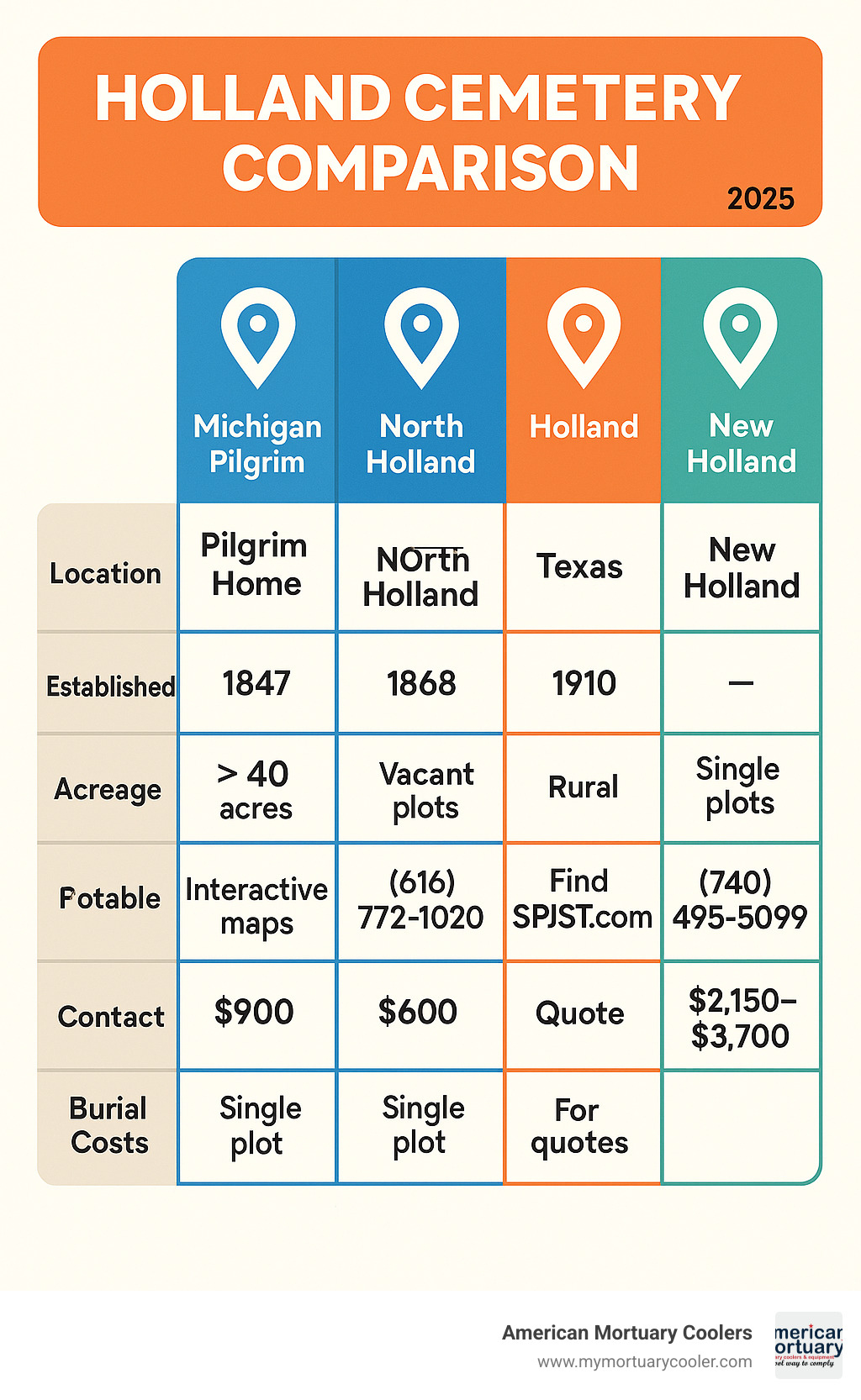
Learn more about holland cemetery:
Understanding Holland Cemetery: Key Facts and History
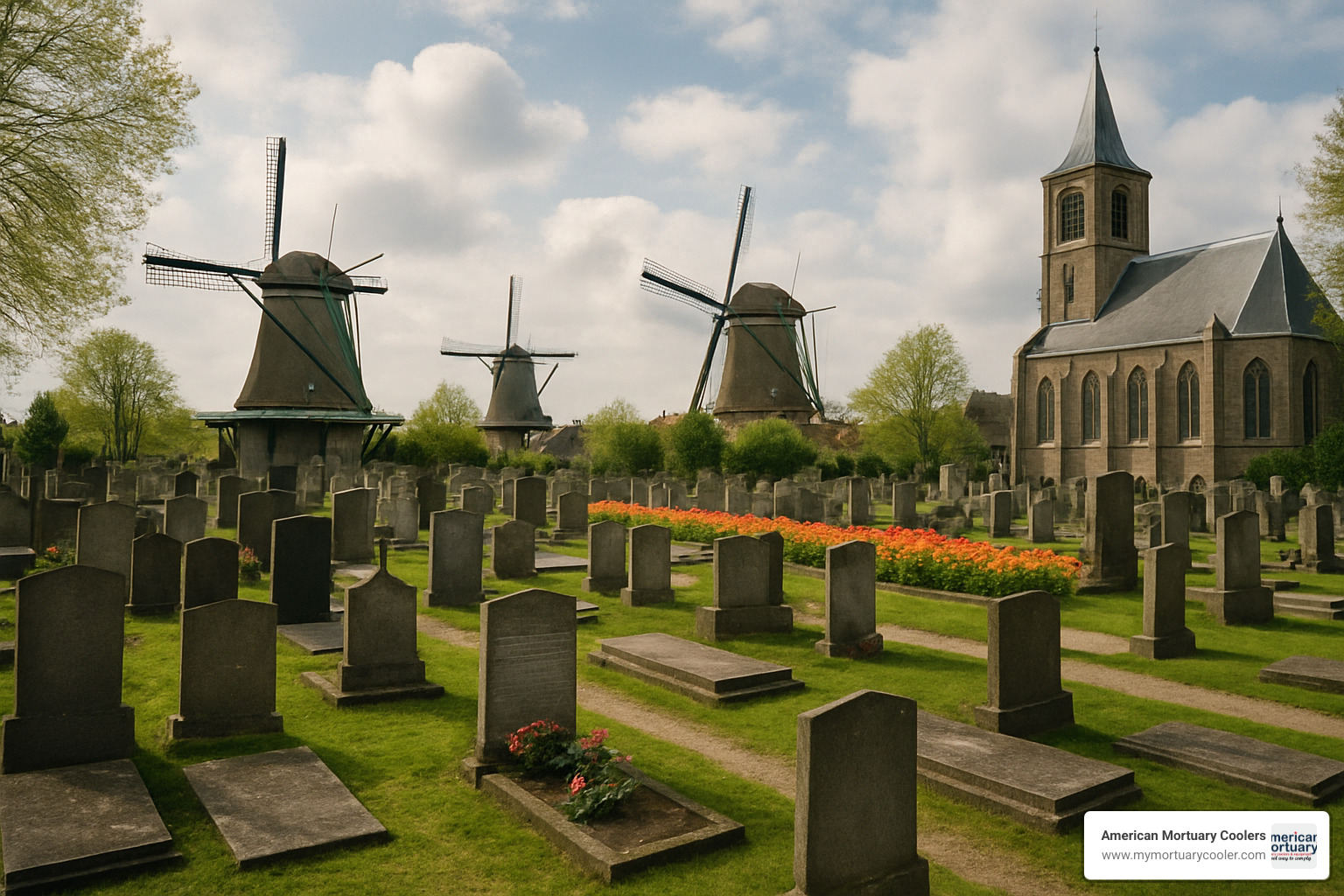
The story of holland cemetery locations across America reflects Dutch immigrant settlement patterns from the mid-1800s. Each location tells a different chapter of families finding home in a new country and creating places to honor their loved ones with dignity.
The crown jewel is Pilgrim Home Cemetery in Holland, Michigan, which started with a humble log church built in 1847 by Dr. A.C. Van Raalte and his Dutch congregation seeking religious freedom. The first burial occurred on September 21, 1854, and the cemetery was officially named on October 31, 1889.
Meanwhile, Holland Cemetery in Bell County, Texas wasn't established until August 8, 1910, when the Holland S.P.J.S.T. Try's Lodge No. 80 decided their community needed a proper burial ground. These fraternal lodges looked out for members in life and ensured dignified resting places in death. Today, this Texas cemetery holds over 2,500 graves. Scientific research on cemetery preservation shows these burial grounds require careful maintenance and detailed record-keeping to serve families for generations.
Where Is "Holland Cemetery" Located?
When someone searches for holland cemetery, they might find several different places across the country. In Michigan, Pilgrim Home Cemetery serves as Holland's main municipal cemetery, while North Holland Cemetery sits on 5.2 acres at 2436 Beeline Road. This smaller cemetery was established in 1868 and still has vacant plots available.
Graafschap Cemetery in the Holland area began when the community purchased a 2-acre parcel in 1859. Texas has its own Holland Cemetery in Bell County, established by the fraternal lodge with beautiful Hill Country views. In Ohio, New Holland Cemetery in Fayette County offers burial plots costing between $2,150 and $3,700. Georgia, Illinois, and Tennessee also have their own holland cemetery locations, typically smaller community burial grounds.
How Did Holland Cemetery Begin?
These holland cemetery locations show three main paths communities took to establish burial grounds in early America.
Religious beginnings created some of the most enduring cemeteries. Dr. Van Raalte's congregation didn't just build a church - they created complete community infrastructure. When their congregation split in 1857 into the Reformed Church in America and the Christian Reformed Church, both groups continued using the same cemetery, showing how shared grief can unite communities.
Fraternal lodges took a different approach, especially in rural areas. The Holland S.P.J.S.T. Try's Lodge No. 80 in Texas saw a community need and stepped up to fill it, with establishment officially recorded in Bell County Volume 209 Page 470.
Municipal takeovers represent the third pattern. Pilgrim Home Cemetery absorbed Fairlawn Cemetery in 1934 when Holland, Michigan took over operations, providing better maintenance, consistent record-keeping, and improved family services.
Layout, Notable Sections & Burials
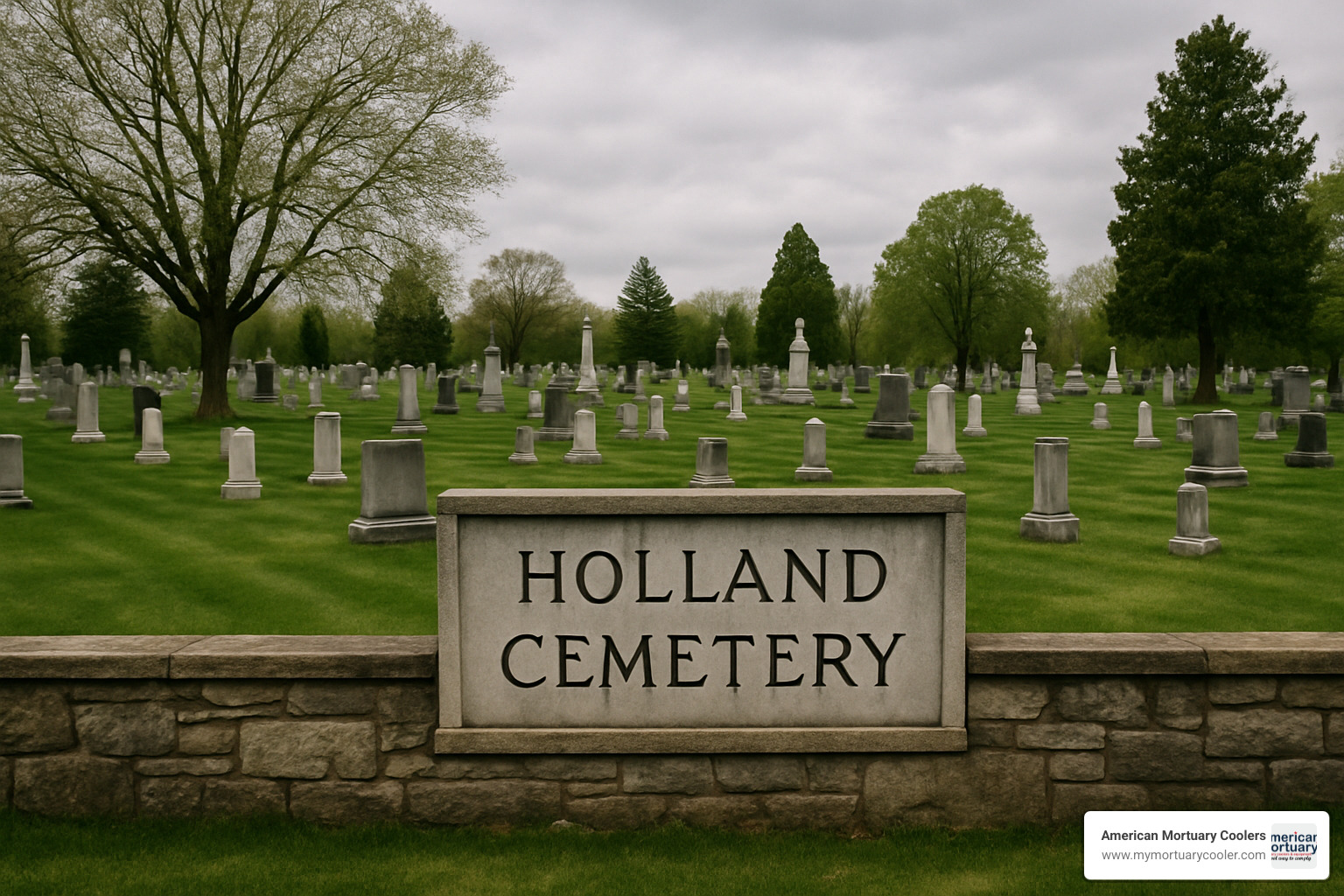
Walking through any holland cemetery tells a story through its layout and design. These burial grounds have grown organically over generations, shaped by community needs and the families they serve.
The most striking feature at Pilgrim Home Cemetery is the commemorative boulder marking where the original log church once stood. Four white markers surround this memorial, along with a 1917 plaque honoring the spiritual foundation of the Dutch settlement. That modest 35 × 60 foot log church from 1847 to 1856 was where both the community's faith and their final resting place began.
Pilgrim Home Cemetery has expanded twice in modern history - first in 1940 when the city converted old fairgrounds into Cemetery Number 3, then again in fall 1991 when they opened the remaining southern acreage. The 2007 columbarium represents the newest chapter, with indoor glass and granite niches accommodating families choosing cremation while keeping loved ones in familiar cemetery grounds.
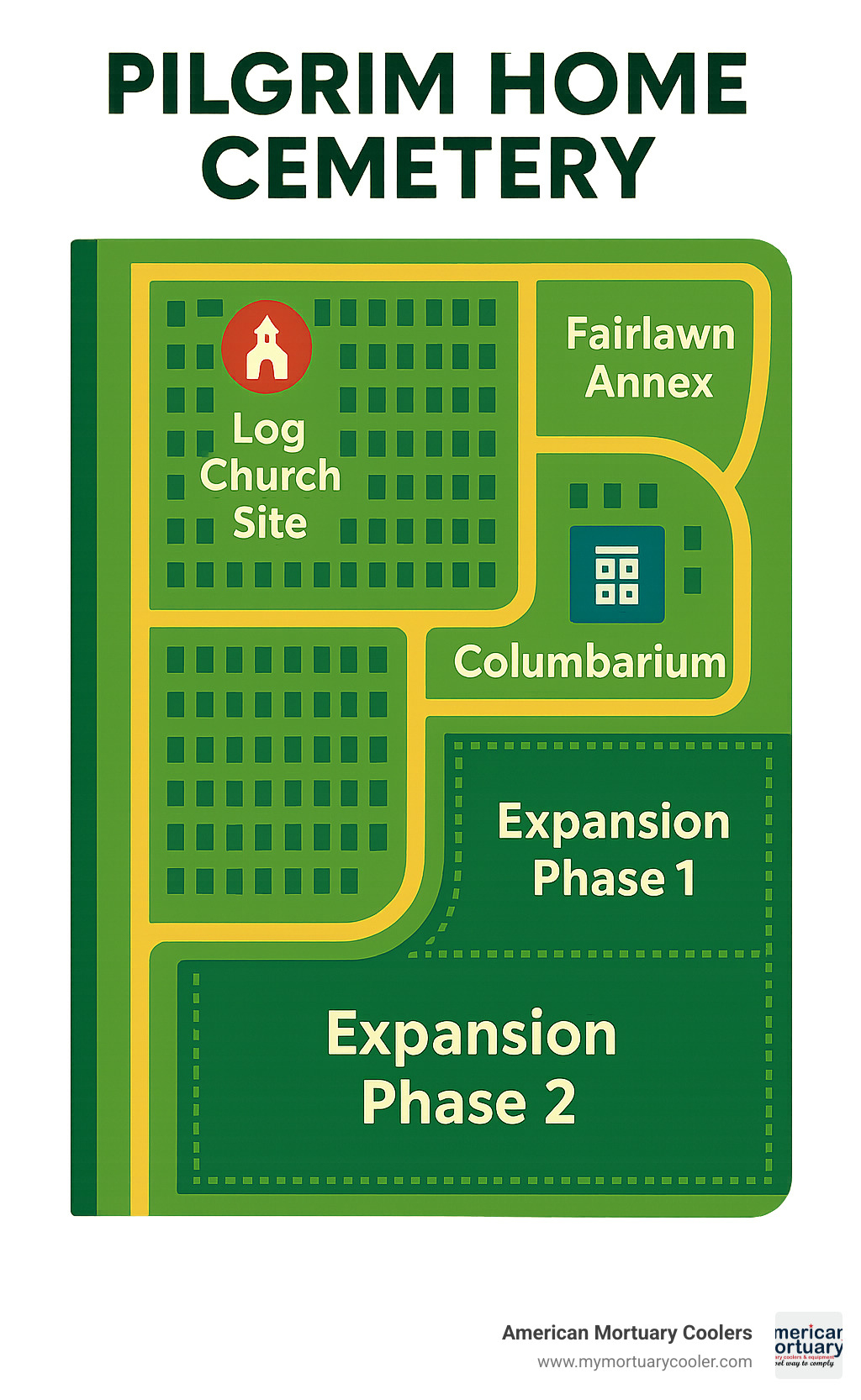
Pilgrim Home & Graafschap Highlights
The Dutch heritage of Holland, Michigan comes alive in these historic cemetery sections. Pioneer plots from the original log church burial ground contain graves dating back to 1854, many with traditional Dutch surnames carved into weathered stones.
The Fairlawn Cemetery section operated independently from 1877 until the city absorbed it in 1934. The Holland Township Cemetery Association managed Fairlawn, with their first burial recorded on September 17, 1877. You can still see organizational differences in headstone styles and plot layouts between sections.
Graafschap Cemetery began when town leaders purchased two acres in 1859 with clever pricing - $1 for residents but $3 for outsiders - encouraging permanent residency. Family plots are organized by immigration waves, with headstones bearing Dutch and English inscriptions representing families honoring their heritage while building American roots.
North Holland Cemetery Features
North Holland Cemetery offers an intimate 5.2-acre setting with tree-lined lanes that feel more like a park. Located at 2436 Beeline Road, this township-managed cemetery has maintained its peaceful character since 1868.
Unlike larger municipal cemeteries, North Holland still has vacant burial sites available, making it an active choice for families seeking burial rights. The 2436 Beeline Road directions make it easy to find. Holland Charter Township handles all operations through their Clerk's office with dawn-to-dusk visiting hours.
Texas & Rural Family Plots
Holland Cemetery in Bell County, Texas sits on rolling Hill Country terrain that showcases Texas's natural beauty. Getting there requires planning - the access road can become impassable during rain without a 4x4 vehicle. The route takes you south on Highway 281 from Burnet to County Road 340A, then through cattle gates.
This holland cemetery contains both marked and unmarked graves, including approximately two unknown graves and seven additional unmarked sites that local history suggests may be Native American burials. One identified grave belongs to Emaline Holland (March 2, 1861 - October 17, 1867), likely from the founding Holland family.
Visiting, Rules & On-Site Services
Planning a visit to holland cemetery is straightforward once you understand the basic guidelines. Most locations welcome visitors from dawn to dusk, giving families flexibility for morning reflection or evening remembrance.
When it comes to decorations, each holland cemetery balances family wishes with practical maintenance needs. Fresh flowers are almost always welcome, and many families enjoy placing seasonal arrangements. Small potted plants usually work well, especially hardy varieties that withstand weather changes.
Most cemeteries conduct seasonal clean-offs - typically in late fall and early spring - to remove weathered decorations and keep grounds looking their best. The on-site services available vary by location, but most holland cemetery facilities coordinate with funeral directors for burial services, handle vault installation, and assist with monument placement. More info about headstone vases can help you understand memorial decoration options.
Regulations You Should Know
Every holland cemetery has rules that help everyone feel comfortable and keep grounds in good condition. Monument specifications cover height limits, width requirements, and approved materials, ensuring monuments fit well together and maintenance crews can access all areas.
Pet policies are standard - dogs are welcome but need leashes, and owners should clean up after them. Vehicle access rules protect graves and landscaping by designating specific roads and parking areas rather than allowing driving across grass.
Holland Charter Township maintains detailed ordinances for North Holland Cemetery covering everything from burial rights transfers to fee structures. Maintenance windows are important to consider when planning visits, as grounds crews need regular access for mowing, tree care, and general upkeep.
Products & Support for Families
The holland cemetery locations work with trusted local vendors to provide everything families need. Monument companies understand specific cemetery requirements and create beautiful, lasting memorials meeting all guidelines.
Burial vault services are essential for most burials, providing casket protection and maintaining ground stability. More info about burial vault prices can help you understand this important component and expected costs.
Cremation options have expanded significantly. Pilgrim Home Cemetery's columbarium offers beautiful indoor glass and granite niches that protect cremated remains while giving families a comfortable place to visit in a climate-controlled environment.
At American Mortuary Coolers, we've worked with cemetery operations across multiple states, from Tennessee to facilities in Atlanta, Chicago, Dallas, and Los Angeles. Our custom mortuary cooling equipment supports behind-the-scenes operations that help these cemeteries serve families with dignity and care.
Buying Plots & Arranging Burials at Holland Cemetery
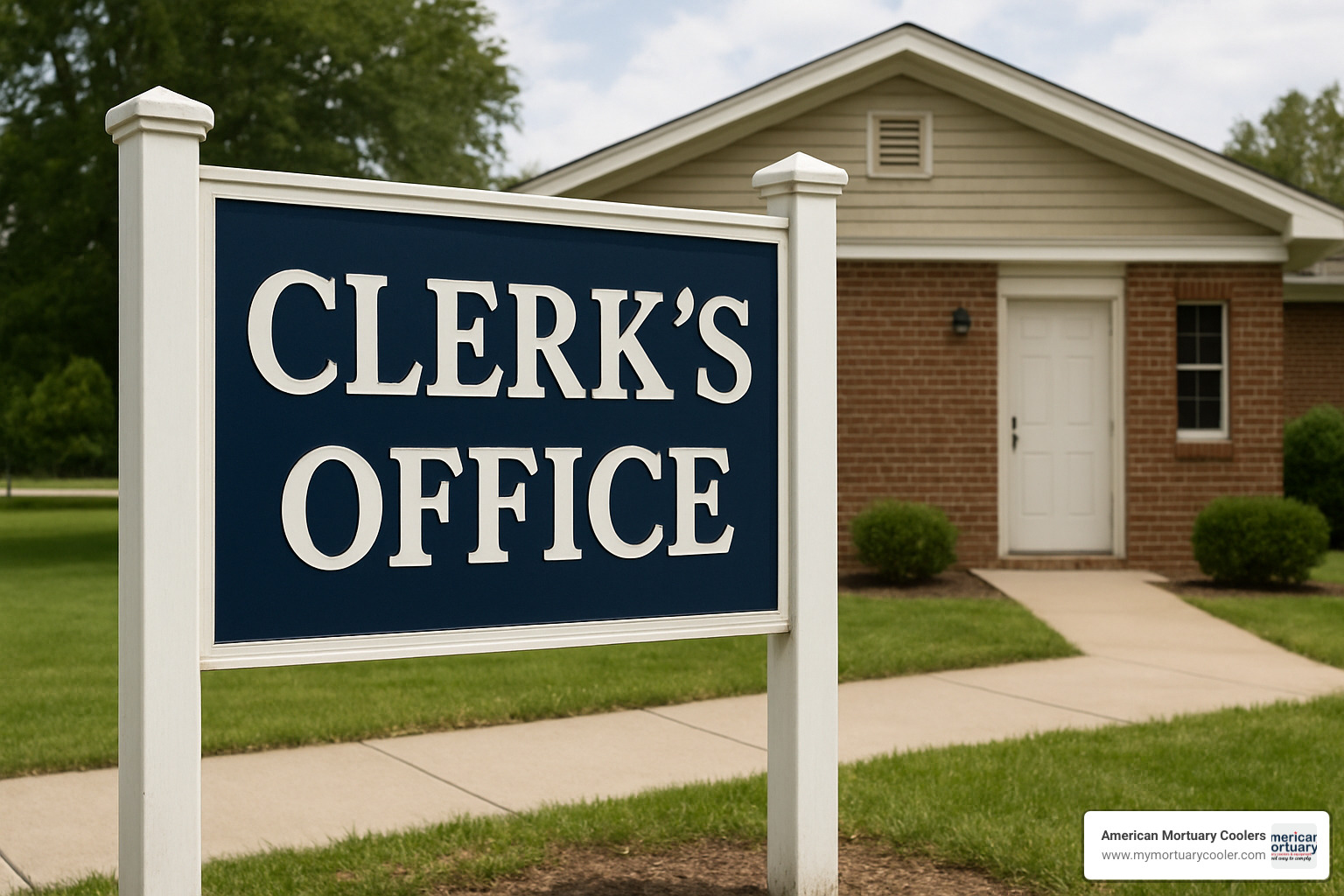
Purchasing burial rights at holland cemetery locations is straightforward once you understand the basics. Each cemetery follows similar steps, though specific details and costs vary by location.
Pricing varies significantly between locations. New Holland Cemetery in Ohio charges between $2,150 and $3,700 for single adult burial plots, with total burial costs starting around $8,600 including plot opening, closing, outer burial containers, grave markers, and administrative fees.
Michigan holland cemetery locations use different fee structures, still following that tradition from 1859 Graafschap Cemetery of charging residents less than non-residents. Endowment fees typically run between $600 and $1,450 on top of plot costs. These fees fund long-term cemetery maintenance including grass cutting, road repairs, and administrative work.
| Location | Plot Cost Range | Endowment Fee | Total Starting Cost |
|---|---|---|---|
| Michigan Holland Cemetery | $1,800-$3,200 | $600-$900 | $2,400-$4,100 |
| Ohio New Holland | $2,150-$3,700 | $800-$1,200 | $2,950-$4,900 |
| Texas Bell County | $1,200-$2,500 | $600-$1,450 | $1,800-$3,950 |
Step-by-Step Purchasing Guide
Getting started with Michigan holland cemetery locations is straightforward. For North Holland Cemetery, call Holland Charter Township at (616) 396-2345 extension 7. For Pilgrim Home or Graafschap Cemeteries, contact the City of Holland Cemetery Division.
Before calling, download fee schedules and cemetery maps from their websites. Look at different sections - some families prefer historic areas near the original log church site, while others like newer sections with wider lanes for easier access.
The paperwork process involves filling out burial rights purchase applications and setting up payment arrangements. Many cemeteries offer payment plans to make costs more manageable. Once approved, the cemetery records your burial rights deed and sets up transfer procedures for future family needs.
Maps & Online Grave-Finders
Finding specific graves used to mean wandering with hand-drawn maps. Most holland cemetery locations now offer digital tools making navigation much easier.
The City of Holland provides an interactive GIS-based cemetery viewer that works like Google Maps for cemetery plots. You can search for specific names, plot numbers, or browse the layout. The system works well on smartphones for use while walking through the cemetery.
For offline reference, downloadable PDF maps cover Graafschap Cemetery and Pilgrim Home Cemetery with both full cemetery maps and detailed section maps. Some newer installations include QR code markers linking directly to digital records when scanned with your phone, bridging traditional cemetery visits with modern technology.
How Holland Cemetery Compares to Other Regional Cemeteries
When families choose a final resting place, understanding how holland cemetery locations compare to other regional options makes the decision easier. These cemeteries have real advantages and some challenges that set them apart.
Capacity planning is where holland cemetery locations shine. Pilgrim Home Cemetery has grown from a simple log church burial ground to over 2,500 graves through smart expansion in 1940 and 1991. Many smaller cemeteries run out of space, but Holland's forward-thinking approach consistently stays ahead of community needs.
The cost comparison shows New Holland Cemetery's total burial costs starting around $8,600 sit in the middle of regional averages - not the cheapest option, but not premium pricing either. Monument installation varies based on soil conditions and cemetery access, with some locations requiring specialized equipment that adds costs.
Maintenance standards represent one of the biggest advantages of municipally-managed holland cemetery locations. Pilgrim Home and North Holland Cemetery offer consistent grounds keeping, well-maintained roads, and reliable access. Smaller private cemeteries often struggle with maintenance budgets, leading to overgrown sections or delayed repairs.
Technology integration sets these cemeteries apart from regional competitors. Holland's interactive cemetery mapping system makes finding graves much easier than wandering with hand-drawn maps. Many area cemeteries still rely entirely on paper records, making family research frustrating.
However, accessibility challenges vary significantly. The Texas holland cemetery requires 4x4 vehicles during wet weather, complicating funeral services and family visits. Michigan locations generally offer better road access and parking facilities.
From our experience at American Mortuary Coolers working with funeral homes and cemeteries across multiple states, the equipment and infrastructure quality at holland cemetery locations reflects their commitment to long-term community service. More info about cemetery equipment shows how proper equipment investment supports better family experiences and operational efficiency.
Holland cemetery locations generally offer solid value through consistent management, reasonable pricing, and community-focused service - though specific advantages depend on which location you're considering and what matters most to your family.
Frequently Asked Questions about Holland Cemetery
When families explore holland cemetery options, they naturally have questions about what to expect. Having worked with funeral homes and cemeteries across the country through American Mortuary Coolers, I've heard these same questions repeatedly.
How many graves are there at the main Holland Cemetery sites?
The numbers tell quite a story about community growth over decades. Pilgrim Home Cemetery in Holland, Michigan holds over 2,500 graves, making it the largest holland cemetery location. Considering this started as a simple burial ground behind a log church in 1847, that's remarkable growth spanning nearly 175 years.
Holland Cemetery in Bell County, Texas also contains over 2,500 graves according to county records. This rural cemetery presents counting challenges - there are approximately two unknown graves and seven additional unmarked graves that local families believe may be Native American burials.
North Holland Cemetery in Michigan takes a different approach. At 5.2 acres, it's much smaller but maintains meticulous records through Holland Charter Township administration, providing exact counts of occupied plots, available spaces, and detailed section maps.
What are the visiting hours and holiday closures?
Almost all holland cemetery locations follow the same schedule: dawn to dusk daily. This gives families flexibility for morning visits or evening reflection. Exact hours shift with seasons - longer access during summer months and shorter windows in winter.
Most cemeteries never actually close for holidays. Memorial Day, Veterans Day, Christmas - these are often the most meaningful times for cemetery visits, so administrators keep gates open. However, administrative offices do close on major holidays, affecting things like purchasing plots or scheduling burial services.
Weather creates real access challenges, especially at rural locations. The Texas Hill Country holland cemetery can become completely impassable during heavy rains, with visitors reporting the need for "a 4x4 vehicle or even a mule" after storms. Always call ahead if weather looks questionable.
Can I contribute photos or corrections to the cemetery records?
Most holland cemetery locations actively welcome community contributions because families often know details that official records miss. The City of Holland specifically encourages photo submissions and corrections for their online cemetery viewer system.
Genealogical societies and historical organizations frequently partner with cemeteries on documentation projects, organizing volunteer days to photograph grave markers, transcribe weathered inscriptions, and collect family stories that bring dry records to life.
The most valuable contributions often come from families with personal connections to the cemetery. You might have old family photos showing grave sites before modern landscaping, or stories passed down about relatives buried in unmarked sections. Cemetery administrators treasure these personal histories because they add human context to names and dates in record books.
Conclusion
The story of holland cemetery locations across America reflects how communities come together to honor those we've lost and preserve meaningful connections. From that first humble log church burial ground in 1847 Michigan to the Texas fraternal lodge cemetery established in 1910, these sacred spaces have quietly served families for over 175 years.
What strikes me most is how they've adapted while staying true to their purpose. The Dutch settlers who buried their loved ones near that original log church couldn't have imagined today's interactive online maps and modern columbariums. Yet the heart of what they created - a place where families can visit and find peace - remains unchanged.
Each holland cemetery location tells its own story. The Michigan sites offer municipal services and digital tools that make finding ancestors' graves easier. Meanwhile, that rural Texas cemetery with its Hill Country views and cattle-gate access reminds us that sometimes the most meaningful places haven't changed much at all.
These cemeteries need our help to keep serving future generations. Whether that's families purchasing plots, volunteers helping with maintenance, or genealogy enthusiasts who photograph headstones and share family stories online - every bit helps. It's amazing how a $1 burial plot from 1859 has evolved into today's comprehensive cemetery services, but that evolution only happened because communities stayed involved.
At American Mortuary Coolers, we see this commitment firsthand. From our Tennessee headquarters to the funeral homes and cemeteries we serve across the country, we witness how these facilities work tirelessly to support families during difficult times. Our custom mortuary cooling equipment might be behind the scenes, but we're proud to help these essential community institutions do their important work.
Whether you're planning ahead for your family, researching genealogy, or managing cemetery operations, holland cemetery locations offer something valuable. They're living history books, peaceful gathering places, and bridges between past and future all rolled into one.
The holland cemetery story isn't finished - it keeps growing as communities change, technology advances, and new families make these places part of their own stories. More info about burial vaults for ashes and other cemetery solutions help ensure these special places can keep adapting to serve families for many generations to come.
That's the real beauty of these cemeteries - they're not just about the past, but about the continuing human need for places where love, memory, and community come together.
















